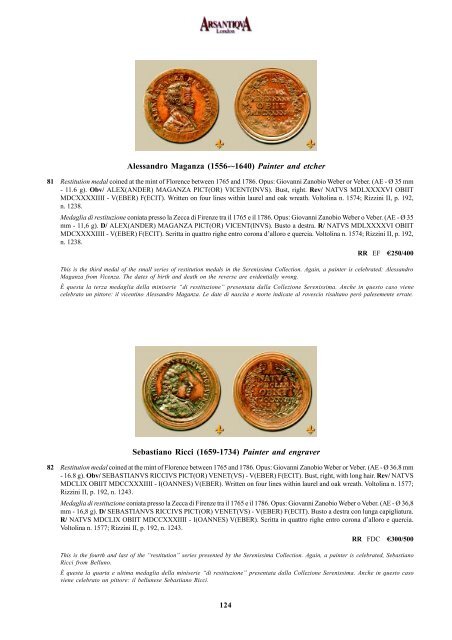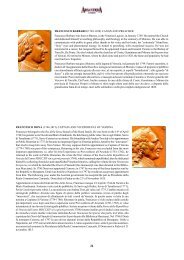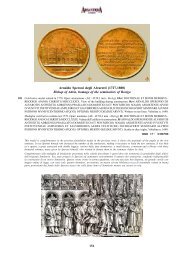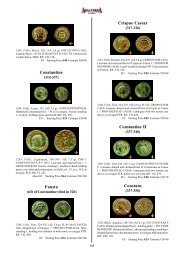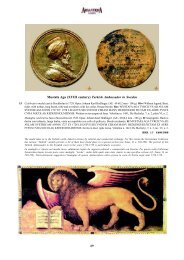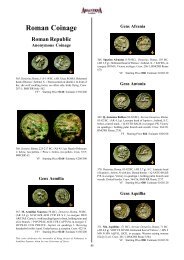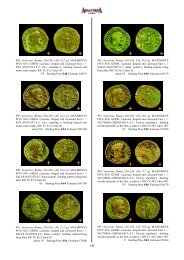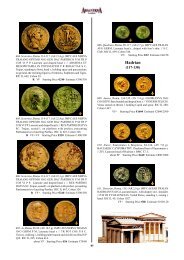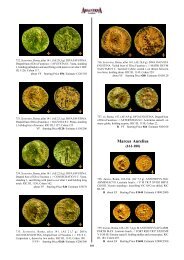Alessandro Maganza (1556-~1640) Painter and etcher ... - Arsantiqva
Alessandro Maganza (1556-~1640) Painter and etcher ... - Arsantiqva
Alessandro Maganza (1556-~1640) Painter and etcher ... - Arsantiqva
Create successful ePaper yourself
Turn your PDF publications into a flip-book with our unique Google optimized e-Paper software.
<strong>Aless<strong>and</strong>ro</strong> <strong>Maganza</strong> (<strong>1556</strong>-<strong>~1640</strong>) <strong>Painter</strong> <strong>and</strong> <strong>etcher</strong><br />
81 Restitution medal coined at the mint of Florence between 1765 <strong>and</strong> 1786. Opus: Giovanni Zanobio Weber or Veber. (AE-Ø35mm<br />
- 11.6 g). Obv/ ALEX(ANDER) MAGANZA PICT(OR) VICENT(INVS). Bust, right. Rev/ NATVS MDLXXXXVI OBIIT<br />
MDCXXXXIIII - V(EBER) F(ECIT). Written on four lines within laurel <strong>and</strong> oak wreath. Voltolina n. 1574; Rizzini II, p. 192,<br />
n. 1238.<br />
Medaglia di restituzione coniata presso la Zecca di Firenze tra il 1765 e il 1786. Opus: Giovanni Zanobio Weber o Veber. (AE-Ø35<br />
mm - 11,6 g). D/ ALEX(ANDER) MAGANZA PICT(OR) VICENT(INVS). Busto a destra. R/ NATVS MDLXXXXVI OBIIT<br />
MDCXXXXIIII - V(EBER) F(ECIT). Scritta in quattro righe entro corona d’alloro e quercia. Voltolina n. 1574; Rizzini II, p. 192,<br />
n. 1238.<br />
RR EF e250/400<br />
This is the third medal of the small series of restitution medals in the Serenissima Collection. Again, a painter is celebrated: <strong>Aless<strong>and</strong>ro</strong><br />
<strong>Maganza</strong> from Vicenza. The dates of birth <strong>and</strong> death on the reverse are evidentially wrong.<br />
È questa la terza medaglia della miniserie “di restituzione” presentata dalla Collezione Serenissima. Anche in questo caso viene<br />
celebrato un pittore: il vicentino <strong>Aless<strong>and</strong>ro</strong> <strong>Maganza</strong>. Le date di nascita e morte indicate al rovescio risultano però palesemente errate.<br />
Sebastiano Ricci (1659-1734) <strong>Painter</strong> <strong>and</strong> engraver<br />
82 Restitution medal coined at the mint of Florence between 1765 <strong>and</strong> 1786. Opus: Giovanni Zanobio Weber or Veber. (AE - Ø 36.8 mm<br />
- 16.8 g). Obv/ SEBASTIANVS RICCIVS PICT(OR) VENET(VS) - V(EBER) F(ECIT). Bust, right, with long hair. Rev/ NATVS<br />
MDCLIX OBIIT MDCCXXXIIII - I(OANNES) V(EBER). Written on four lines within laurel <strong>and</strong> oak wreath. Voltolina n. 1577;<br />
Rizzini II, p. 192, n. 1243.<br />
Medaglia di restituzione coniata presso la Zecca di Firenze tra il 1765 e il 1786. Opus: Giovanni Zanobio Weber o Veber. (AE - Ø 36,8<br />
mm - 16,8 g). D/ SEBASTIANVS RICCIVS PICT(OR) VENET(VS) - V(EBER) F(ECIT). Busto a destra con lunga capigliatura.<br />
R/ NATVS MDCLIX OBIIT MDCCXXXIIII - I(OANNES) V(EBER). Scritta in quattro righe entro corona d’alloro e quercia.<br />
Voltolina n. 1577; Rizzini II, p. 192, n. 1243.<br />
RR FDC e300/500<br />
This is the fourth <strong>and</strong> last of the “restitution” series presented by the Serenissima Collection. Again, a painter is celebrated, Sebastiano<br />
Ricci from Belluno.<br />
È questa la quarta e ultima medaglia della miniserie “di restituzione” presentata dalla Collezione Serenissima. Anche in questo caso<br />
viene celebrato un pittore: il bellunese Sebastiano Ricci.<br />
124
Abbondio Rezzonico (1742-1810)<br />
Senator in Rome during the eight years of Papacy of his uncle Clemente XIII<br />
83 Celebrative medal coined at Rome in 1766. Opus: Antonio Pazzaglia. (AR - Ø 62.8 mm - 81 g). Obv/ ABVNDIVS REZZONICO<br />
SENATOR VRBIS - PAZZAGLIA. Bust, right, with long hair <strong>and</strong> an embroidered robe. Rev/ CLEMENTIS XIII P(ONTIFICIS)<br />
M(AXIMI) PATRVI ANNO VIII - MDCCLXVI. The statue of Rome seated on a throne, at her feet trophies of arms <strong>and</strong> st<strong>and</strong>ards.<br />
Voltolina n. 1579; Correr sec. XVII/XVIII, p. 107, n. 87; Forrer IV, p. 440.<br />
Medaglia celebrativa coniata a Roma nel 1766. Opus: Antonio Pazzaglia. (AR - Ø 62,8 mm - 81 g). D/ ABVNDIVS REZZONICO<br />
SENATOR VRBIS - PAZZAGLIA. Busto a destra con lunga capigliatura e veste ricamata. R/ CLEMENTIS XIII P(ONTIFICIS)<br />
M(AXIMI) PATRVI ANNO VIII - MDCCLXVI. La statua di Roma seduta in trono, ai suoi piedi trofei d’armi ed insegne.<br />
Voltolina n. 1579; Correr sec. XVII/XVIII, p. 107, n. 87; Forrer IV, p. 440.<br />
RRR EF e1800/3000<br />
In 1765 Abbondio Rezzonico was elected Senator in Rome. This appointment was given by the expressed will of his uncle, Pope Clemente<br />
XIII. The Senator of Rome was the highest lay magistrate in the city, head of a municipal team of 48 Consiglieri <strong>and</strong> two Ecclesiastical<br />
Deputies of the secular <strong>and</strong> regular clergy; he was also extremely close to the Pope <strong>and</strong> was admitted to the Camera Segreta. The<br />
prestigious appointment was celebrated with a portrait by Pompeo Batoni <strong>and</strong> the coining of a medal, here on offer as a precious silver<br />
example.<br />
Nel 1765 Abbondio Rezzonico fu eletto Senatore di Roma. La carica gli venne conferita per espressa volontà dello zio Pontefice Clemente<br />
XIII. Il Senatore di Roma era il primo magistrato laico della città, capo di un corpo municipale composto da 48 Consiglieri e due<br />
Deputati ecclesiastici del clero secolare e regolare; egli inoltre poteva vantare una straordinaria vicinanza al Papa ed era ammesso alla<br />
sua Camera Segreta. Il prestigioso incarico venne celebrato con l’esecuzione di un ritratto opera di Pompeo Batoni e con la coniazione<br />
della medaglia, qui proposta in un prezioso esemplare in argento.<br />
125
Abbondio Rezzonico (1742-1810)<br />
Senator in Rome in the eight year<br />
of Papacy of his uncle Clemente XIII<br />
84 Celebrative medal coined at Rome in 1766. Opus:Antonio Pazzaglia.<br />
(AE - Ø 62.8 mm - 82 g). Obv/ ABVNDIVS REZZONICO<br />
SENATOR VRBIS - PAZZAGLIA. Bust, right, with long hair <strong>and</strong><br />
an embroidered robe. Rev/ CLEMENTIS XIII P(ONTIFICIS)<br />
M(AXIMI) PATRVI ANNO VIII - MDCCLXVI. The statue of<br />
Rome seated on a throne, at her feet trophies of arms <strong>and</strong> st<strong>and</strong>ards.<br />
Voltolina, n. 1579; Correr, sec. XVII/XVIII, p. 107, n. 87; Forrer, IV,<br />
p. 440.<br />
Medaglia celebrativa coniata a Roma nel 1766. Opus: Antonio<br />
Pazzaglia. (AE - Ø 62,8 mm - 82 g). D/ ABVNDIVS REZZONICO<br />
SENATOR VRBIS - PAZZAGLIA. Busto a destra con lunga capigliatura<br />
e veste ricamata. R/ CLEMENTIS XIII P(ONTIFICIS)<br />
M(AXIMI) PATRVI ANNO VIII - MDCCLXVI. La statua di Roma<br />
seduta in trono, ai suoi piedi trofei d’armi ed insegne. Voltolina,<br />
n. 1579; Correr, sec. XVII/XVIII, p. 107, n. 87; Forrer, IV, p. 440.<br />
RRR FDC e700/1000<br />
Ex Volonté Collection, Milan.<br />
See previous historical note.<br />
Cfr. scheda storica precedente.<br />
126<br />
Scuola della Passione in Venice<br />
85 Celebrative medal coined at the mint of Venice in 1766. Opus: anonymous. (AR - Ø<br />
40.5 mm - 6.2 g). Obv/ IESVS NAZAR(ENVS) REX IVDEOR(VM). Bust of Jesus,<br />
left. Rev/ SANCTE MARIAE LAVRETANAE INTERCES(SIO)<br />
PROTE(CTIOQVE) - 1766. The Holy Church held by Cherubs; above, on the<br />
clouds, bust of the haloed Virgin holding the Child with rayed head. Voltolina n. 1582.<br />
Medaglia celebrativa coniata presso la Zecca di Venezia nel 1766. Opus: anonimo.<br />
(AR - Ø 40,5 mm - 6,2 g). D/ IESVS NAZAR(ENVS) REX IVDEOR(VM). Busto di<br />
Gesù a sinistra. R/ SANCTE MARIAE LAVRETANAE INTERCES(SIO)<br />
PROTE(CTIOQVE) - 1766. La Santa Casa sostenuta da Cherubini; sopra di questa,<br />
appoggiato sulle nuvole, busto della Vergine aureolata con in braccio il Bambin Gesù<br />
con il capo raggiante. Voltolina n. 1582.<br />
RRR VF e500/800<br />
This fine medal, coined in silver, shows the vitality of the Confraternita della Passione<br />
which had been much followed by the Venetian population ever since it was founded in<br />
1560 (see Venus I, nn. 235, 282-294; Venus II, n. 152). In this example, on the reverse<br />
instead of the usual representation of the Passion of Christ, there is the devotion for the<br />
Madonna of Loreto.<br />
Questa bella medaglia, coniata in argento, testimonia la vitalità della Confraternita<br />
della Passione che godette di largo seguito tra la popolazione veneziana sin dal suo<br />
primo sorgere, nel 1560 (cfr. Venus I, nn. 235, 282-294; Venus II, n. 152). In questo<br />
caso, nel rovescio, in luogo della più comune rappresentazione della Passione di Cristo<br />
si ritrova la devozione per la Madonna di Loreto.
Scuola Gr<strong>and</strong>e di Santa Maria della Carità in Venezia,<br />
to Giambattista Schioppalalba<br />
86 Celebrative medal coined at the mint of Venice in 1767. Opus: anonymous. (AE<br />
- Ø 50.5 mm - 45.8 g). Obv/ IO(ANNI) BAPTISTAE SCHIOPPALALBA<br />
PHILOLOGO. Representation of the precious reliquary. Rev/ ANNO<br />
MDCCLXVII SODALITAS CARITATIS. Potentate Cross in two circles, symbol<br />
of the Scuola della Carità. Voltolina n. 1584 (otherwise unpublished).<br />
Medaglia celebrativa coniata presso la Zecca di Venezia nel 1767. Opus: anonimo.<br />
(AE - Ø 50,5 mm - 45,8 g). D/ IO(ANNI) BAPTISTAE SCHIOPPALALBA<br />
PHILOLOGO. Rappresentazione del prezioso reliquiario. R/ ANNO<br />
MDCCLXVII SODALITAS CARITATIS. Croce ancorata intrecciata con due<br />
cerchi concentrici, simbolo della Scuola della Carità. Voltolina n. 1584<br />
(altrimenti inedita).<br />
RRRR FDC e1500/2000<br />
The medal, issued in 1767 while Gian Giacomo Corniani was Guardian Gr<strong>and</strong>e (he<br />
was born in 1726), celebrates the Abbot Giambattista Schioppalalba, chaplain of<br />
the Scuola della Carità, a great scholar of the classical world, who had published<br />
that year an accurate description of the precious reliquary donated by the Cardinal<br />
Bessarione to the Scuola della Carità in 1463. When the Scuola was suppressed<br />
(1806) the reliquary was at first bought by the Count Luigi Savorgnan, <strong>and</strong>, later, by<br />
the Austrian Emperor for the Vienna Museum; it would return only in 1919, when it<br />
was put in the galleries of the Accademia. The rarity <strong>and</strong> splendid conservation of<br />
this medal, which belongs to the much sought-after typology of the Venetian Scuole<br />
Gr<strong>and</strong>i, make this example particularly interesting.<br />
La medaglia, emessa nel 1767 mentre era Guardian Gr<strong>and</strong>e Gian Giacomo Corniani<br />
(nato nel 1726), celebra l’Abate Giambattista Schioppalalba, cappellano della<br />
Scuola della Carità, gr<strong>and</strong>e studioso del mondo classico che, in quell’anno, aveva<br />
pubblicato una accurata descrizione del prezioso reliquiario donato dal Cardinale<br />
Bessarione alla Scuola della Carità fin dal 1463. Alla soppressione della Scuola (1806) il reliquiario venne dapprima acquistato dal<br />
Conte Luigi Savorgnan e, successivamente, dall’Imperatore d’Austria per essere collocato nei Musei di Vienna; di qui sarebbe ritornato<br />
solo nel 1919, per trovare definitiva sistemazione nelle gallerie dell’Accademia. La rarità e la straordinaria conservazione di questo<br />
esemplare, appartenente alla tipologia molto ambita delle Scuole Gr<strong>and</strong>i di Venezia, rendono particolarmente interessante questa<br />
medaglia.<br />
Girolamo Emiliani or Miani (1486-1537)<br />
Canonised together with five other Saints by Pope Clemente XIII<br />
87 Celebrative medal coined at the mint of Rome in 1768. Opus: Ferdin<strong>and</strong>o Hamerani,<br />
attributed. (AE - Ø 39.7 mm - 25.2 g). Obv/ CLEMENS XIII PONT(IFEX) M(AXIMVS)<br />
A(NNO) X. Bust, right, with embroidered stole. Rev/ DECOR EIVS GLORIA<br />
SANCTORVM - AN(NO) MDCCLXVIII. The six new Saints on clouds with a rayed<br />
sky; from left to right: S. Giovanni Canzio, S. Giuseppe Colasanzio, S. Girolamo Emiliani,<br />
S. Giuseppe da Copertino, S. Serafino d’Ascoli <strong>and</strong> S.ta Giovanna Francesca Frémyot de<br />
Chantal. Voltolina n. 1586; Bartolotti p. 186, n. E 768; Lincoln n. 1904.<br />
Medaglia celebrativa coniata presso la Zecca di Roma nel 1768. Opus: Ferdin<strong>and</strong>o<br />
Hamerani, attribuita. (AE - Ø 39,7 mm - 25,2 g). D/ CLEMENS XIII PONT(IFEX)<br />
M(AXIMVS) A(NNO) X. Busto a destra con camauro, mozzetta e stola ricamata.<br />
R/ DECOR EIVS GLORIA SANCTORVM - AN(NO) MDCCLXVIII. I sei nuovi Santi<br />
in atteggiamento di devozione su nubi con il cielo irraggiato; da sinistra a destra: S.<br />
Giovanni Canzio, S. Giuseppe Colasanzio, S. Girolamo Emiliani, S. Giuseppe da<br />
Copertino, S. Serafino d’Ascoli e S.ta Giovanna Francesca Frémyot de Chantal. Voltolina<br />
n. 1586; Bartolotti p. 186, n. E 768; Lincoln n. 1904.<br />
RR EF+ e150/200<br />
On the 27th of October 1767, the Venetian Pope, Clemente XIII (Carlo Rezzonico), canonised<br />
San Giovanni Canzio, San Giuseppe Colasanzio, San Giuseppe da Copertino, San Serafino,<br />
Santa Giovanna Francesca Frémyot <strong>and</strong> San Girolamo Emiliani (or Miani); the latter was<br />
also a Venetian. Venice celebrated the sanctification of Emiliani with ceremonies <strong>and</strong> gave<br />
4000 ducati to the Congregazione at S. Maria della Salute; the Doge Alvise IV Mocenigo<br />
also dedicated the annual osella of 1768 to the Venetian Saint.<br />
Il 27 ottobre 1767 il Pontefice veneziano Clemente XIII (Carlo Rezzonico) canonizzava San Giovanni Canzio, San Giuseppe Colasanzio,<br />
San Giuseppe da Copertino, San Serafino, Santa Giovanna Francesca Frémyot e San Girolamo Emiliani (o Miani), quest’ultimo<br />
veneziano anch’esso. Venezia celebrò la santificazione dell’Emiliani con particolari cerimonie ed elargì 4000 ducati alla Congregazione<br />
residente presso S. Maria della Salute, inoltre il Doge Alvise IV Mocenigo dedicò l’annuale osella del 1768 alla figura del Santo<br />
veneziano.<br />
127
The Senate to the subjects of Venetian Albania<br />
during the dogato of Alvise IV Mocenigo<br />
88 Merit medal coined at the mint of Venice in 1769. Opus: anonymous. (AV - Ø 36.7 mm - 13.8<br />
g1 ). Obv/ ALOISIVS MOCENICO DVX - 1769. Lion in majesty. Dotted border.<br />
Rev/ FIDEI SVBDITORVM SENATVS. Written on three lines between decorations above<br />
<strong>and</strong> below; border of dots <strong>and</strong> rosettes. Voltolina n. 1587; Von Heyden n. 147-148; Majer<br />
1927, p. 43-44, n. 38, pho. p. 53; Morosini p. 18, n. 66.<br />
1 This weight corresponded to four zecchini.<br />
Medaglia di benemerenza coniata presso la Zecca di Venezia nel 1769. Opus: anonimo. (AV<br />
- Ø 36,7 mm - 13,8 g1 ). D/ ALOISIVS MOCENICO DVX - 1769. Leone in maestà. Bordo<br />
perlinato. R/ FIDEI SVBDITORVM SENATVS. Scritta in tre righe fra ornati in alto e in<br />
basso; bordo di rosette e perlinatura. Voltolina n. 1587; Von Heyden nn. 147-148; Majer<br />
1927, pp. 43-44, n. 38, fot. p. 53; Morosini p. 18, n. 66.<br />
RRRR FDC e12000/18000<br />
1 Con questo peso corrispondeva all’equivalente di quattro zecchini.<br />
Ex Donà delle Rose Collection - ex listino Ratto n. XIII, 1934, n. 700.<br />
A gold medal in itself is exceptional, not only for the value of the metal <strong>and</strong> the rarity, but for its history <strong>and</strong> the reasons it avoided being<br />
melted, like so many gold objects. This example has been studied <strong>and</strong> has precise archive documents. In 1768 the Venetian Senate wanted<br />
to reward the Albanian subjects that had cooperated in reducing to obedience the three towns of Pobori, Braichi <strong>and</strong> Maini, situated on<br />
the border with Montenegro; they had revolted against the Venetian authority on the incitement of a Russian impostor. On the 14th of<br />
January the Venetian mint was commissioned to coin 40 gold medals for a total of 116 zecchini: 12 of the value of 4 zecchini, 12 of 3<br />
zecchini <strong>and</strong> 16 of 2 zecchini. The medal here on offer, in an extraordinary conservation, is one of the 12 more precious ones, that of the<br />
value of 4 zecchini.<br />
Una medaglia d’oro costituisce di per sè un qualcosa di eccezionale, non solo per il valore intrinseco del metallo e per la rarità, ma anche<br />
per la storia che la pervade, per le vicende che le hanno consentito di sfuggire al crogiuolo in cui sono finiti tanti altri oggetti d’oro.<br />
Questo esemplare è stato approfonditamente studiato ed è accompagnato da precise documentazioni d’archivio. Nel 1768 il Senato<br />
Veneto volle premiare i sudditi Albanesi che avevano cooperato a ridurre all’obbedienza i tre comuni di Pobori, Braichi e Maini situati<br />
alle falde del Montenegro che, sobillati da un impostore russo, si erano ribellati all’autorità veneta. Il 14 gennaio vennero commissionate<br />
alla Zecca di Venezia 40 medaglie d’oro per una spesa complessiva di 116 zecchini: 12 da 4 zecchini, 12 da 3 zecchini e 16 da 2<br />
zecchini. Quella che viene qui proposta in una straordinaria conservazione è una delle 12 più preziose, quella da 4 zecchini.<br />
The Senate to the subjects of Venetian Albania<br />
during the dogato of Alvise IV Mocenigo<br />
89 Merit medal coined at the mint of Venice in 1769. Opus: anonymous. (AR - Ø 38.7 mm -<br />
16.9 g). Obv/ ALOISIVS MOCENICO DVX - 1769. Lion in majesty. Dotted border.<br />
Rev/ FIDEI SVBDITORVM SENATVS. Written on three lines between decorations above<br />
<strong>and</strong> below; border of dots <strong>and</strong> rosettes. Voltolina n. 1587; Von Heyden n. 147-148; Majer<br />
1927, p. 43-44, n. 38, pho. p. 53; Morosini p. 18, n. 66.<br />
Medaglia di benemerenza coniata presso la Zecca di Venezia nel 1769. Opus: anonimo.<br />
(AR - Ø 38,7 mm - 16,9 g). D/ ALOISIVS MOCENICO DVX - 1769. Leone in maestà.<br />
Bordo perlinato. R/ FIDEI SVBDITORVM SENATVS. Scritta in tre righe fra ornati in alto<br />
e in basso; bordo di rosette e perlinatura. Voltolina n. 1587; Von Heyden nn. 147-148; Majer<br />
1927, pp. 43-44, n. 38, fot. p. 53; Morosini p. 18, n. 66.<br />
RRRR Small piercing on the border. EF+ e3000/4000<br />
Ex Lucheschi Collection.<br />
As well as the gold medal, presented in the previous lot, the Serenissima Collection offers a<br />
silver example of great rarity <strong>and</strong> prestige.<br />
Accanto alla medaglia d’oro presentata nella scheda precedente, la Collezione Serenissima<br />
propone questo esemplare in argento di gr<strong>and</strong>e rarità e prestigio.<br />
128
Giovanni Battista Rezzonico (1740-1783)<br />
Prefect of the Sacri Palazzi Apostolici <strong>and</strong> Governor of the Conclave<br />
90 Celebrative medal coined at the mint of Rome in 1769. Opus: anonymous. (AE - Ø 28.5 mm - 8.8<br />
g). Obv/ SEDE VACANTE. In the field, the Rezzonico coat of arms surmounted by a Cardinal’s<br />
hat. Rev/ IOH(ANNES) BAPTISTA REZZONICVS S(ACRI) PAL(ATII) APOST(OLICI)<br />
PRAEFECTVS ET CONCLAVIS GVBERNATOR MDCCLXIX. Written on seven lines. Voltolina<br />
n. 1589; Johnson 1990, III, n. 697.<br />
Medaglia celebrativa coniata presso la Zecca di Roma nel 1769. Opus: anonimo. (AE - Ø 28,5 mm<br />
- 8,8 g). D/ SEDE VACANTE. Nel campo stemma gentilizio dei Rezzonico sormontato da cappello<br />
cardinalizio. R/ IOH(ANNES) BAPTISTA REZZONICVS S(ACRI) PAL(ATII) APOST(OLICI)<br />
PRAEFECTVS ET CONCLAVIS GVBERNATOR MDCCLXIX. Scritta in sette righe. Voltolina<br />
n. 1589; Johnson 1990, III, n. 697.<br />
RR EF e300/500<br />
Arnaldo Speroni degli Alvarotti (1727-1800)<br />
Bishop of Adria. Foundation of the Church of<br />
S. Maria di Villa Guardia Ferrarese<br />
91 Foundation medal cast in 1770. Opus: anonymous. (AE - Ø 65.2 mm<br />
-88g).Obv/ D(OMINVS) ARNALDVS SPERONIVS NOB(ILIS)<br />
PATAV(INVS) EPISC(OPVS) ADRIEN(SIS) PRIMVM<br />
LAP(IDEM) POS(VIT). Bust, right, in ecclesiastical robes <strong>and</strong> cross.<br />
Rev/ ECCLESIA SANCTAE MARIAE VILLAE GVARDIAE<br />
FERRARIENSIS FVNDATA V IDVS SEPTEMBRIS MDCCLXX.<br />
Written on seven lines, with bishop’s arms <strong>and</strong> priestly st<strong>and</strong>ard.<br />
Voltolina n. 1592; Johnson 1990, III, n. 683; Rizzini II, p. 222,<br />
n. 1396.<br />
Medaglia di fondazione fusa nel 1770. Opus: anonimo. (AE - Ø 65,2<br />
mm-88g).D/ D(OMINVS)ARNALDVS SPERONIVS NOB(ILIS)<br />
PATAV(INVS) EPISC(OPVS) ADRIEN(SIS) PRIMVM<br />
LAP(IDEM) POS(VIT). Busto a destra in veste ecclesiale con croce<br />
pettorale. R/ ECCLESIA SANCTAE MARIAE VILLAE GVARDIAE<br />
FERRARIENSIS FVNDATA V IDVS SEPTEMBRIS MDCCLXX.<br />
Scritta in sette righe, stemma vescovile e insegne prelatizie. Voltolina<br />
n. 1592; Johnson 1990, III, n. 683; Rizzini II, p. 222, n. 1396.<br />
RR Small piercing closed with wax. EF e400/600<br />
Giovanni Battista Rezzonico had been elected Prefect of the Sacri Palazzi in 1766; in 1769, at the<br />
death of his uncle the Pope (Clemente XIII) he was Governor of the Conclave, with a pomp <strong>and</strong><br />
magnificence that aroused universal admiration. The medal was made during the “sede vacante”.<br />
Giovanni Battista Rezzonico era stato eletto fin dal 1766 Prefetto dei Sacri Palazzi; nel 1769, alla<br />
morte dello zio pontefice (Clemente XIII) egli sostenne l’incarico di Governatore del Conclave con uno<br />
sfarzo e una magnificenza tali da incontrare l’universale ammirazione. La medaglia venne realizzata<br />
proprio nel periodo di “sede vacante”.<br />
Sperone Speroni degli Alvarotti held the diocese of Adria for 34 years,<br />
during which time he promoted the building of many churches. In this<br />
case, the laying of the first stone for the new Parochial church of S.<br />
Maria di Villa Guardia Ferrarese is commemorated; an example of this<br />
medal was placed in the foundations.<br />
Sperone Speroni degli Alvarotti resse la diocesi di Adria per 34 anni,<br />
nel corso dei quali promosse la costruzione di numerose chiese. In<br />
questo caso viene ricordata la posa della prima pietra della nuova<br />
Chiesa parrocchiale di S. Maria di Villa Guardia Ferrarese, nelle cui<br />
fondamenta venne posto anche un esemplare di questa medaglia.<br />
129
College of San Marco in Padua (1771-1796)<br />
92 Merit medal coined at the mint of Venice around 1771. Opus: anonymous. (Gilded AE - Ø 36.6 mm - 25.4 g). Obv/ COLLEGIUM<br />
DIVI MARCI. Written on three lines between two ornaments, above <strong>and</strong> under. Rev/ S(ENATUS) C(ONSULTO). Above <strong>and</strong><br />
under, ornaments with leaves. Voltolina n. 1597 (otherwise unpublished).<br />
Medaglia di benemerenza coniata presso la Zecca di Venezia intorno al 1771. Opus: anonimo. (AE dorato - Ø 36,6 mm - 25,4 g).<br />
D/ COLLEGIUM DIVI MARCI. Scritta in tre righe tra due ornamenti sopra e sotto. R/ S(ENATUS) C(ONSULTO). Sopra e sotto<br />
due elementi ornamentali con foglie. Voltolina n. 1597 (altrimenti inedita).<br />
RRRR VF e600/800<br />
This extremely rare medal is an interesting document of the desire to reform the entire education system in the Venetian State between<br />
1770 <strong>and</strong> 1780. Faced with the low level of the students starting their University career, the Reformers of the Paduan University, with the<br />
m<strong>and</strong>ate from the Government, decided to found a model college in Padua, to prepare students for the university. The College of San<br />
Marco was opened in 1771, in the suppressed monastery of Sant’Antonio. 53 youngsters were put up in as many rooms (many were poor<br />
nobles) <strong>and</strong> had to be present at the College on the 11th of November, <strong>and</strong> remain there until “their exams”. They had to wear a uniform<br />
with the symbol of the College of San Marco embroidered in gold. The medal was an identification mark <strong>and</strong> an incentive that the<br />
Venetian Government, much involved in this reform, gave to the best pupils. The College was closed on the 23rd of December 1796, when<br />
the building was required for barracking a battalion of soldiers.<br />
Questa rarissima medaglia costituisce una interessante testimonianza di quel desiderio di riforma dell’intero sistema dell’educazione che<br />
pervase lo Stato veneto tra il 1770 e il 1780. Di fronte al basso livello evidenziato dagli studenti che affrontavano la carriera universitaria,<br />
i Riformatori dello Studio di Padova, su m<strong>and</strong>ato del Governo, decisero di istituire a Padova un collegio modello, preparatorio agli studi<br />
universitari. Nacque così, nel 1771, il Collegio di San Marco, nel soppresso Monastero di Sant’Antonio. In altrettante camerette vennero<br />
ospitati 53 giovani (perlopiù patrizi poveri) che erano tenuti a presentarsi in Collegio l’11 novembre, per rimanerci sino al “Respettivo<br />
Esame”. Essi dovevano portare una divisa con il simbolo del Collegio di San Marco ricamato in oro. La medaglia costituiva un<br />
riconoscimento e un incentivo che il Governo veneto, tanto coinvolto in questa operazione di riforma, assegnava ai giovani più capaci.<br />
La storia del Collegio si chiuse il 23 dicembre 1796, qu<strong>and</strong>o i locali furono sequestrati per ospitare un battaglione di soldati.<br />
130
Stephen I (969-1038)<br />
King of Hungary, Saint for the translation of the reliquary from Ragusa to Buda<br />
93 Celebrative medal coined at Vienna in 1771. Opus: anonymous. (AR - Ø 42.2 mm - 26.1 g). Obv/ DEXTERA B(EATI) STEPHANI<br />
REGIS ET CONFESSORIS GLORIOSI. The precious reliquary, surmounted by royal crown, with the left h<strong>and</strong> of the Saint.<br />
Rev/ QUAM AB AN(NO) MXC AD MDXXVI IN HUNGAR(IA) TUM RAGUSAE ULTRA II SEC(ULA) CULTAM IOS(EPH)<br />
II ET M(ARIA) THER(ESIA) AUGG 1 MDCCLXXI XXIX MAII RECUPERARUNT ET POST IX DIER(UM) DEVOTIONEM<br />
HUNG(ARIS) D(ONO) D(EDERUNT) BUDAE QUOT ANNIS PUBL(ICAE) VENERATIONI PROPONENDAM. Written on<br />
twelve lines between two friezes, above <strong>and</strong> below. Voltolina n. 1598; Mimica p. 404; Probstzt p. 331, n. 237; Fiala Stempel, 969.<br />
1 AUGG st<strong>and</strong>s for AUGUSTI.<br />
Medaglia celebrativa coniata a Vienna nel 1771. Opus: anonimo. (AR - Ø 42,2 mm - 26,1 g). D/ DEXTERA B(EATI) STEPHANI<br />
REGIS ET CONFESSORIS GLORIOSI. Il prezioso reliquiario, sormontato dalla corona reale contenente la reliquia della mano<br />
destra del Beato. R/ QUAM AB AN(NO) MXC AD MDXXVI IN HUNGAR(IA) TUM RAGUSAE ULTRA II SEC(ULA)<br />
CULTAM IOS(EPH) II ET M(ARIA) THER(ESIA) AUGG1 MDCCLXXI XXIX MAII RECUPERARUNT ET POST IX<br />
DIER(UM) DEVOTIONEM HUNG(ARIS) D(ONO) D(EDERUNT) BUDAE QUOT ANNIS PUBL(ICAE) VENERATIONI<br />
PROPONENDAM. Scritta in dodici righe tra due fregi sopra e sotto. Voltolina n. 1598; Mimica p. 404; Probstzt p. 331, n. 237;<br />
Fiala Stempel, n. 969.<br />
RR FDC e1200/1800<br />
1 AUGG sta per AUGUSTI.<br />
The medal illustrates the solemn translation of the reliquary of the right h<strong>and</strong> of Saint Stephen, king of Hungary (canonised by Pope<br />
Gregorio VII in 1083). The reliquary arrived in Ragusa after the year 1526, <strong>and</strong> had been kept <strong>and</strong> venerated for over 200 years. In 1771,<br />
after requests by the Emperor Joseph II <strong>and</strong> the Empress Maria Theresa of Austria, the city agreed to give back the precious reliquary to<br />
Buda. On the 29 of May 1771, the h<strong>and</strong> of the Saintly King was sent to Vienna, where, by order of the Empress, it was shown for nine days<br />
in the Chapel of the Schoenbrunn palace. Later, it was placed in a precious shrine, shown on the obverse of the medal, <strong>and</strong> taken to<br />
Hungary. This event was much publicised, as the many medals in different metals show. The one here on offer is a precious example in<br />
a large size, coined in silver; but there are also two smaller medals made with slightly different dies. The Serenissima Collection offers both<br />
variations of the smaller medal (see n. 94-95).<br />
La medaglia illustra la solenne traslazione della reliquia della mano destra di Santo Stefano Re di Ungheria (canonizzato da Papa<br />
Gregorio VII nel 1083). La reliquia era giunta a Ragusa dopo il 1526 e vi era stata conservata e venerata per oltre 200 anni. Nel 1771,<br />
dietro sollecitazione dell’Imperatore Giuseppe II e dell’Imperatrice Maria Teresa d’Austria, la città dalmata aveva consentito a restituire<br />
la preziosa reliquia alla città di Buda. Il 29 maggio 1771 la mano del Re Santo venne inviata a Vienna, dove, per ordine dell’Imperatrice,<br />
fu esposta per nove giorni nella cappella del Castello di Schoenbrunn. Successivamente, posta nella ricca teca raffigurata nel dritto della<br />
medaglia, venne traslata in Ungheria. L’avvenimento ebbe notevole rilievo, come evidenzia la realizzazione di più medaglie in diversi<br />
metalli. Quello che viene qui proposto è un prezioso esemplare di gr<strong>and</strong>e modulo, coniato in argento, ma esistono anche due medaglie<br />
di modulo inferiore realizzate con due conii leggermente diversi fra loro. La Collezione Serenissima è in grado di proporre entrambe le<br />
varianti del modulo più piccolo (cfr. nn. 94-95).<br />
131
Stephen I (969-1038)<br />
King of Hungary, Saint for the translation of the reliquary from Ragusa to Buda<br />
94 Celebrative medal coined at Vienna in 1771. Opus: anonymous. (AR - Ø 25.8 mm -4g).Obv/ DEXTERA B(EATI) STEPHANI<br />
REGIS ET CONFESSORIS GLORIOSI. The precious reliquary, surmounted by royal crown, with the left h<strong>and</strong> of the Saint.<br />
Rev/ QUAM AB A(NNO) MXC AD MDXXVI IN HUN(GARIA) TUM RAG(USAE) ULT(RA) II SEC(ULA) CULT(AM)<br />
IOS(EPH) II ET M(ARIA) THER(ESIA) AUG(USTI) MDCCLXXI XXIX MAI(I) RECUP(ERARUNT) ET POST IX DIER(UM)<br />
DEVOT(IONEM) HU(NGARIS) D(ONO) D(EDERUNT) BUD(AE) QUOT AN(NIS) PUB(LICAE) VENERAT(IONI)<br />
PROPONEND(AM). Written on ten lines between two friezes, above <strong>and</strong> below. Voltolina n. 1599; Fiala Stempel, 970.<br />
Medaglia celebrativa coniata a Vienna nel 1771. Opus: anonimo. (AR - Ø 25,8 mm -4g).D/ DEXTERA B(EATI) STEPHANI<br />
REGIS ET CONFESSORIS GLORIOSI. Il prezioso reliquiario, sormontato dalla corona reale contenente la reliquia della mano<br />
destra del Beato. R/ QUAM AB A(NNO) MXC AD MDXXVI IN HUN(GARIA) TUM RAG(USAE) ULT(RA) II SEC(ULA)<br />
CULT(AM) IOS(EPH) II ET M(ARIA) THER(ESIA) AUG(USTI) MDCCLXXI XXIX MAI(I) RECUP(ERARUNT) ET POST<br />
IX DIER(UM) DEVOT(IONEM) HU(NGARIS) D(ONO) D(EDERUNT) BUD(AE) QUOT AN(NIS) PUB(LICAE)<br />
VENERAT(IONI) PROPONEND(AM). Scritta in dieci righe tra due fregi sopra e sotto. Voltolina n. 1599; Fiala Stempel, n. 970.<br />
RR EF e250/400<br />
It is the first type of medal made with a 25 mm module, for the translation of the reliquary of Saint Stephen, King of Hungary. For the<br />
historical reasons for this event, see the previous note.<br />
Si tratta del primo tipo della medaglia realizzata con modulo di 25 mm, per la traslazione delle reliquie di Santo Stefano Re d’Ungheria.<br />
Sulle circostanze storiche che la determinarono cfr. scheda storica precedente.<br />
Stephen I (969-1038)<br />
King of Hungary, Saint for the translation of the reliquary from Ragusa to Buda<br />
95 Celebrative medal coined at Vienna in 1771. Opus: anonymous. (AR - Ø 25.2 mm -4g).Obv/ DEXTERA B(EATI) STEPHANI<br />
REGIS ET CONFESSORIS GLORIOSI. The precious reliquary, surmounted by royal crown, with the left h<strong>and</strong> of the Saint.<br />
Rev/ QUAM AB A(NNO) MXC AD MDXXVI IN HUN(GARIA) TUM RAG(USAE) ULT(RA) II SEC(ULA) CULT(AM)<br />
IOS(EPH) II ET M(ARIA) THER(ESIA) AUG(USTI) MDCCLXXI XXIX MAI(I) RECUP(ERARUNT) ET POST IX DIER(UM)<br />
DEVOT(IONEM) HU(NGARIS) D(ONO) D(EDERUNT) BUD(AE) QUOT AN(NIS) PUB(LICAE) VENERAT(IONI)<br />
PROPONEND(AM). Written on ten lines between two friezes, above <strong>and</strong> below. Voltolina n. 1599/b; Fiala Stempel, 970.<br />
Medaglia celebrativa coniata a Vienna nel 1771. Opus: anonimo. (AR - Ø 25,2 mm -4g).D/ DEXTERA B(EATI) STEPHANI<br />
REGIS ET CONFESSORIS GLORIOSI. Il prezioso reliquiario, sormontato dalla corona reale contenente la reliquia della mano<br />
destra del Beato. R/ QUAM AB A(NNO) MXC AD MDXXVI IN HUN(GARIA) TUM RAG(USAE) ULT(RA) II SEC(ULA)<br />
CULT(AM) IOS(EPH) II ET M(ARIA) THER(ESIA) AUG(USTI) MDCCLXXI XXIX MAI(I) RECUP(ERARUNT) ET POST<br />
IX DIER(UM) DEVOT(IONEM) HU(NGARIS) D(ONO) D(EDERUNT) BUD(AE) QUOT AN(NIS) PUB(LICAE)<br />
VENERAT(IONI) PROPONEND(AM). Scritta in dieci righe tra due fregi sopra e sotto. Voltolina n. 1599/b; Fiala Stempel, n. 970.<br />
RR EF e250/400<br />
It is the second type of medal made with a module of 25 mm, for the translation of the reliquary of Saint Stephen, King of Hungary. It is<br />
immediately obvious that the reverse was made with a different die from the previous medal; the friezes above <strong>and</strong> below the legend are<br />
completely different, larger <strong>and</strong> positioned in a different way with regard to the writing.<br />
Si tratta del secondo tipo della medaglia realizzata con modulo di 25 mm, per la traslazione delle reliquie di Santo Stefano Re<br />
d’Ungheria. Appare evidente che il rovescio è stato eseguito con un conio diverso da quello della medaglia precedente; infatti i fregi<br />
sopra e sotto la scritta sono nettamente differenti, più gr<strong>and</strong>i e posizionati diversamente rispetto alla scritta stessa.<br />
132
Giovanni Battista Morgagni (1682-1771)<br />
Doctor <strong>and</strong> famous anatomist<br />
96 Celebrative medal coined at Bologna in 1771. Opus: Obv/ Joseph Lückner; Rev/ Francesco Barattini. (AE -Ø51mm-45.7 g).<br />
Obv/ I(OHANNES) B(APTISTA) MORGAGNVS ANATOMICVS AET(ATE) XC - LVCKNER. Bust, right, with cloak.<br />
Rev/ PROXIMOS OCCVPAVIT HONORES - MDCCLXXI - F(RANCISCVS) B(ARATTINI) F(ECIT). Aesculapius st<strong>and</strong>ing<br />
with his left h<strong>and</strong> resting on long stick with a serpent around it; at right Telesforo, the cloaked god of convalescents (from a statuary<br />
group in the Palazzo Massimo alle Colonne in Rome); at left, an open book with an anatomic head surmounted by an owl.<br />
Voltolina n. 1601; Forrer I, p. 120, III, p. 489; Johnson 1990, n. 272, 407.<br />
Medaglia celebrativa coniata a Bologna nel 1771. Opus: D/ Joseph Lückner; R/ Francesco Barattini. (AE -Ø51mm-45,7 g).<br />
D/ I(OHANNES) B(APTISTA) MORGAGNVS ANATOMICVS AET(ATE) XC - LVCKNER. Busto a destra con mantellina.<br />
R/ PROXIMOS OCCVPAVIT HONORES - MDCCLXXI - F(RANCISCVS) B(ARATTINI) F(ECIT). Al centroAsclepio (Esculapio<br />
presso i Romani) stante con la mano sinistra appoggiata ad un lungo bastone con il serpente attorcigliato, a destra Telesforo, il genio<br />
ammantato dio dei convalescenti (dal gruppo statuario posto a Roma nel Palazzo Massimo alle Colonne), alla sinistra un libro aperto<br />
con sopra una testa anatomica sovrastata da una civetta. Voltolina n. 1601; Forrer I, p. 120, III, p. 489; Johnson 1990, nn. 272, 407.<br />
RR EF+ e300/500<br />
On the 5th of December 1771 Giovanni Battista Morgagni died, at almost ninety; he founded pathological anatomy. This medal was<br />
made in his honour. The obverse is signed by Joseph Lückner, from Hildesheim (Germany); the reverse has the initials F. B., normally<br />
attributed to Filippo Balugani, although some think it is Francesco Barattini, medallist working in Bologna in this period.<br />
Il 5 dicembre 1771 moriva, quasi novantenne, Giovanni Battista Morgagni, fondatore dell’anatomia patologica. In suo onore venne<br />
realizzata questa medaglia. Il dritto è firmato da Joseph Lückner, di Hildesheim (Germania); il rovescio reca invece le iniziali: F. B., che<br />
sono normalmente attribuite a Filippo Balugani; altri commentatori pensano invece a Francesco Barattini, medaglista in quel periodo<br />
operante a Bologna.<br />
133
Marco Carburi (1731-1808)<br />
Professor of Chemistry <strong>and</strong> experimenter<br />
97 Merit medal coined at the mint of Venice in 1772. Opus:Antonio Schabel. (AE - Ø 51.1 mm - 72.2 g). Obv/ RESPUBLICAVENETA<br />
- A(NTONIUS) SCHABEL FEC(IT). The Lion of San Marco, lying left, with open book <strong>and</strong> on pedestal. Rev/ M(ARCO)<br />
COM(ITI) CARBURIO P(ROFESSORI) CHYMICAE ANTEC(ESSORI) MUNIFICENTIA SENATUS A(NNO) MDCCLXXII.<br />
Written on five lines; two crossed cannons with cannon balls, two Baroque friezes above <strong>and</strong> below. Voltolina n. 1604; Ratto XIII,<br />
n. 506.<br />
Medaglia di benemerenza coniata presso la Zecca di Venezia nel 1772. Opus: Antonio Schabel. (AE - Ø 51,1 mm - 72,2 g).<br />
D/ RESPUBLICAVENETA - A(NTONIUS) SCHABEL FEC(IT). Il Leone di San Marco, accosciato e retrospiciente verso sinistra,<br />
con libro aperto e seduto su basamento. R/ M(ARCO) COM(ITI) CARBURIO P(ROFESSORI) CHYMICAE ANTEC(ESSORI)<br />
MUNIFICENTIA SENATUS A(NNO) MDCCLXXII. Scritta in cinque righe; due fusti di cannone incrociati con relative palle, due<br />
fregi barocchi in alto e in basso. Voltolina n. 1604; Ratto XIII, n. 506.<br />
RRRR FDC e1000/1300<br />
There is a vast documentation on this merit medal. In 1772 the Venetian Senate asked Marco Carburi, chemistry professor at the<br />
University of Padua, to research for a non-combustible paper for artillery, so that gunpowder could be wrapped in it. The results were<br />
extremely brilliant; Carburi’s results were better than the English ones. On the 18th of April of the same year, the Senate decided to give<br />
Carburi a gold medal worth 24 zecchini. The medal, made on the 30th of April 1772, cost 74 ducati. Some bronze examples of this medal<br />
were made, probably to give to personalities present at the award ceremony; the great rarity of this example shows that not many<br />
examples were made.<br />
Su questa medaglia di benemerenza esiste una vasta documentazione. Nel 1772 il Senato veneto incaricò Marco Carburi, professore di<br />
chimica presso l’Università di Padova, di sperimentare una carta non combustibile, a uso dell’artiglieria, come avvolgente per la<br />
polvere da sparo. I risultati furono molto brillanti: il prodotto del Carburi si dimostrò superiore persino a quello inglese. Il 18 aprile dello<br />
stesso anno venne allora deliberato dal Senato di assegnare al Carburi una medaglia d’oro del valore di 24 zecchini. La medaglia,<br />
realizzata il 30 aprile 1772, comportò una spesa di 74 ducati. Della medaglia vennero realizzati anche alcuni esemplari in bronzo,<br />
donati probabilmente alle personalità intervenute alla premiazione; la gr<strong>and</strong>e rarità della medaglia qui proposta indica che tali<br />
esemplari furono decisamente pochi.<br />
134
Andrea Benedetto Ganassoni (1734-1786) Archbishop of Corfu<br />
98 Celebrative medal with artistic cornice 1 , cast around 1773. Opus: anonymous. (AR - oval 43.2x37.5 mm - 16.9 g). Obv/ D(IVVS)<br />
ANDR(EAS) BENEDICT(VS) ARCHIEP(ISCOPVS) CORCYR(AE). Bust, right, with zucchetto <strong>and</strong> cross. Ornate border.<br />
Rev/ PAX. Archbishop’s arms <strong>and</strong> motto, surmounted by a hat with two cords with a total of twelve ribbons. Voltolina n. 1607<br />
(otherwise unpublished).<br />
1 Cornice made with a leaf of gilded silver that forms the original loop.<br />
Medaglia celebrativa con artistica cornice1 , fusa intorno al 1773. Opus: anonimo. (AR - ovale 43,2 x 37,5 mm - 16,9 g). D/ D(IVVS)<br />
ANDR(EAS) BENEDICT(VS) ARCHIEP(ISCOPVS) CORCYR(AE). Busto a destra con zucchetto e mozzetta, croce pendente sul<br />
petto. Bordo modanato. R/ PAX. Stemma arcivescovile, con motto, sormontato dal cappello dal quale scendono due cordoni con un<br />
totale di dodici fiocchi. Voltolina n. 1607 (altrimenti inedita).<br />
RRRR EF e2000/3000<br />
1 Cornice realizzata con lamierino di argento dorato che forma anche l’antico appiccagnolo.<br />
Ex Pisani Collection.<br />
The medal celebrates the election of Andrea Benedetto Ganassoni as Archbishop of Corfu, which took place on the 28th of August 1773.<br />
The consecration took place only on the 20th of December. Chronicles describe in a positive way Ganassoni’s behaviour on the Greek<br />
isl<strong>and</strong>; but he could not bear the sea climate <strong>and</strong> insistently asked to be transferred elsewhere. On the 12th of July 1779 he was transferred<br />
to the diocese of Feltre. We offer a very rare example in silver of the medal.<br />
La medaglia celebra l’elezione di Andrea Benedetto Ganassoni all’Arcivescovato di Corfù, avvenuta il 28 agosto 1773. Di fatto però la<br />
consacrazione avvenne solo il 20 dicembre successivo. Le cronache descrivono in termini molto positivi il comportamento del Ganassoni<br />
in quest’isola greca; egli, però, mal sopportava il clima marittimo e chiese insistentemente di poter passare altrove. Il 12 luglio 1779<br />
ottenne il trasferimento alla diocesi di Feltre. Della medaglia viene qui proposto un rarissimo esemplare in argento.<br />
135
Scuola Gr<strong>and</strong>e of San Giovanni Evangelista in Venice<br />
99 Celebrative medal cast at Venice in 1773. Opus: anonymous. (AR - Ø 45.8 mm - 30 g). Obv/ Without inscription. San Giovanni,<br />
seated, holding in his right h<strong>and</strong> a pen <strong>and</strong> in his left the open Gospel. Under, at right, an eagle. Rev/ 1773. Above the date, the<br />
reliquary of the Cross, with the scene of the Crucifixion, <strong>and</strong>, at right <strong>and</strong> left, the Madonna <strong>and</strong> San Giovanni.<br />
Medaglia celebrativa fusa a Venezia nel 1773. Opus: anonimo. (AR - Ø 45,8 mm - 30 g). D/ Anepigrafo. San Giovanni, seduto, tiene<br />
nella mano destra la penna e regge con la sinistra il Vangelo aperto. In basso, a destra, l’aquila. R/ 1773. Sopra la data, il reliquiario della<br />
Croce, costituito da Gesù crocifisso con, ai suoi piedi, a destra e a sinistra, la Madonna e San Giovanni.<br />
RRRR EF e1500/2000<br />
Ex Pisani Collection.<br />
Founded in March 1261 as the Devotional Confraternita dei Battuti, San Giovanni Evangelista was one of the original five Scuole Gr<strong>and</strong>i<br />
in Venice. It was directed by a group of confratelli that formed the “Banca” <strong>and</strong> the “Zonta” <strong>and</strong> the role lasted a year. The end of the<br />
m<strong>and</strong>ate was celebrated with a distribution on behalf of the Guardian Gr<strong>and</strong>e or Guardian da Matin, of the so-called “palme” to the<br />
colleagues of the “Banca”; originally they were rarely medals. At the end of the XVIII century the execution <strong>and</strong> distribution of the annual<br />
medal became a question of honour for this <strong>and</strong> the other Scuole Gr<strong>and</strong>i. “Series” were made, which became so important that in some<br />
cases it was ruled that one medal was given to the Scuola so it could be kept. These medals are much sought-after today, but the fact that<br />
they were produced in a limited number (not more than a dozen examples) makes them difficult to find. The Serenissima Collection offers<br />
the opportunity to buy a good number of them. This medal on offer was made in 1773, when the major roles of the Scuola Gr<strong>and</strong>e of San<br />
Giovanni Evangelista were the following: Guardian Gr<strong>and</strong>e Luca Fusi, Vicario Bortolo Biffi, Guardian da Matin Felice Pezzi, Cancelliere<br />
Anzolo Bajamonte Capitanio.<br />
Sorta nel marzo del 1261 come Confraternita devozionale dei Battuti, quella di San Giovanni Evangelista fu una delle cinque Scuole<br />
Gr<strong>and</strong>i originarie di Venezia. A reggerla era un gruppo di confratelli che formavano la “Banca”e la “Zonta” e duravano in carica un<br />
anno. La scadenza del m<strong>and</strong>ato era celebrata con la distribuzione, da parte del Guardian Gr<strong>and</strong>e o del Guardian da Matin, delle<br />
cosiddette “palme” ai colleghi di “Banca”; inizialmente solo di rado esse consistevano in medaglie. Sul finire del Settecento però la<br />
realizzazione e la distribuzione della medaglia annuale diventò quasi un punto d’onore per questa come per le altre Scuole Gr<strong>and</strong>i. Si<br />
costituirono così delle “serie” la cui importanza apparve subito evidente, tanto che in alcuni casi fu imposto per regolamento che almeno<br />
una medaglia venisse consegnata alla Scuola per essere archiviata. Queste medaglie sono oggi molto ambite ma il fatto che esse<br />
venissero realizzate in un numero limitato (difficilmente superiore a poche decine di esemplari) rende particolarmente problematico il<br />
loro reperimento. La Collezione Serenissima offre l’opportunità, probabilmente irripetibile, di poterne acquisire un numero cospicuo.<br />
Quanto alla medaglia in questione, essa venne realizzata nel 1773, qu<strong>and</strong>o le maggiori cariche della Scuola Gr<strong>and</strong>e di San Giovanni<br />
Evangelista erano così ripartite: Guardian Gr<strong>and</strong>e Luca Fusi, Vicario Bortolo Biffi, Guardian da Matin Felice Pezzi, Cancelliere Anzolo<br />
Bajamonte Capitanio.<br />
136
137
Medal offered by Angelo Querini (1721-1796) to the philosopher Voltaire (1694-1778)<br />
100 Celebrative medal cast at Venice in 1773. Opus:Antonio Canova (on the drawing by Giambattista Locatelli). (AE - Ø 121 mm - 695<br />
g). Obv/ MAR(IE) FRAN(ÇOIS) AROVET DE VOLTAIRE - VENETIIS MDCCLXXIII. Bust of the philosopher, turned right.<br />
Rev/ EXAEQVAT VICTORIA COELO. Man in military dress on a winged horse right, holding a caduceus in his raised right h<strong>and</strong>,<br />
defeating a dragon.<br />
Medaglia celebrativa fusa a Venezia nel 1773. Opus: Antonio Canova (su disegno di Giambattista Locatelli). (AE - Ø 121 mm - 695<br />
g). D/ MAR(IE) FRAN(ÇOIS) AROVET DE VOLTAIRE - VENETIIS MDCCLXXIII. Busto del filosofo volto a destra.<br />
R/ EXAEQVAT VICTORIA COELO. Personaggio in abiti militari su cavallo alato a destra, il caduceo nella destra levata, nell’atto di<br />
atterrare il drago.<br />
RRRR EF+ e1500/2000<br />
This very rare medal (only one other example is known, in the Correr Museum in Venice) was modelled by the sixteen year-old Antonio<br />
Canova, based on a drawing by Giambattista Locatelli, from Verona, <strong>and</strong> commissioned by the Venetian Senator Angelo Querini (1721<br />
1796). The medal was dedicated to the philosopher Voltaire, of whom Querini was an admirer. There is a documentation about this<br />
medal, that is to be published by the Rivista Italiana di Numismatica: the medallion was worked <strong>and</strong> cast in bronze in 1773 in an<br />
underground room of the Villa Altichiero,which belonged to Querini, so that it would remain a secret. Only in 1777 did Querini go to<br />
Ferney, where he met Voltaire <strong>and</strong> gave him the medal, which was much appreciated.<br />
Questo rarissimo medaglione (è nota l’esistenza di un solo altro esemplare conservato presso il Museo Correr di Venezia) fu modellato<br />
dall’allora sedicenne Antonio Canova su disegno del veronese Giambattista Locatelli e su commissione del Senatore veneziano Angelo<br />
Querini (1721-1796). Esso fu dedicato al filosofo Voltaire, di cui il Querini era ammiratore. Al riguardo esiste una circostanziata<br />
documentazione in corso di pubblicazione presso la Rivista Italiana di Numismatica: il medaglione fu lavorato e fuso in bronzo nel 1773<br />
in una stanza sotterranea della Villa Altichiero, proprietà del Querini, perché l’esecuzione rimanesse segreta. Solo nel 1777 il Querini,<br />
recatosi a Ferney, incontrò il Voltaire present<strong>and</strong>ogli il dono che fu molto apprezzato.<br />
Medal for the Church of Sant’Edvige - The painter Bernardino Galliari (1707-1794)<br />
101 Celebrative medal coined in 1773. Opus: anonymous. (AE - Ø 41.4 mm - 32.4 g). Obv/ RELIGIO PROMOVETARTES. On the left,<br />
the Church of Sant’Edvige; above, the Saint on clouds; at right, the three Graces, the one in the centre holding a laurel wreath, at the<br />
sides, the other two holding an oval with the bust of the painter. Rev/ B(ERNARDINO) GALLIARI PEDEM AB ANDURNO QUI<br />
SUO AERE OPIFICIO CATHOLICUM S HEDWIG TEMP(LUM) BEROLINI DECORAVIT ET PERFECIT A(NNO)<br />
MDCCLXXIII. Written on eight lines.<br />
Medaglia celebrativa coniata nel 1773. Opus: anonimo. (AE - Ø 41,4 mm - 32,4 g). D/ RELIGIO PROMOVET ARTES. Sulla<br />
sinistra la Chiesa di Sant’Edvige; in alto la Santa su un cuscino di nuvole; sulla destra le tre Grazie: una, al centro solleva una corona<br />
d’alloro, ai lati, le altre due, sostengono un tondo con il busto del pittore. R/ B(ERNARDINO) GALLIARI PEDEMABANDURNO<br />
QUI SUO AERE OPIFICIO CATHOLICUM S HEDWIG TEMP(LUM) BEROLINI DECORAVIT ET PERFECIT A(NNO)<br />
MDCCLXXIII. Scritta in otto righe.<br />
R EF e150/250<br />
The medal refers to the Church of Sant’Edvige in Berlin, built by order of the Emperor Frederick II, on the insistence <strong>and</strong> financial help<br />
of Cardinal Querini (see n. 69). The work, which started in 1747, was stopped in 1755 for financial reasons, <strong>and</strong> started again in 1773.<br />
On this occasion the painter, Bernardino Galliari (1707-1794), from Vercelli, offered to decorate the inside of the church for free. The<br />
medal celebrates his generous gesture.<br />
La medaglia si riferisce alla Chiesa di Sant’Edvige a Berlino, costruita per ordine dell’Imperatore Federico II, ma su sollecitazione e con<br />
il contributo del Cardinale Querini (cfr. n. 69). I lavori, iniziati nel 1747, erano stati interrotti nel 1755 per difficoltà finanziarie; ripresero<br />
nel 1773. In quell’occasione il pittore vercellese Bernardino Galliari (1707-1794) si offrì di decorare gratuitamente l’interno. La<br />
medaglia celebra il suo gesto generoso.<br />
138


